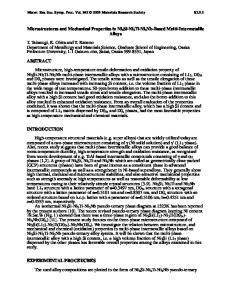Alloying Effect of Ta on Microstructure and Mechanical Properties of Ni 3 (Si, Ti) Intermetallic Alloy
- PDF / 1,854,921 Bytes
- 6 Pages / 432 x 648 pts Page_size
- 50 Downloads / 377 Views
Alloying Effect of Ta on Microstructure and Mechanical Properties of Ni3(Si,Ti) Intermetallic Alloy Daiki Imajo, Yasuyuki Kaneno and Takayuki Takasugi Department of Materials Science, Graduate School of Engineering, Osaka Prefecture University, 1-1Gakuen-cho Naka-ku, Sakai, Osaka 599-8531, JAPAN ABSTRACT The refractory element Ta was added to L12-type Ni3(Si,Ti) intermetallic alloys in order to substitute for Ti. The microstructure and the mechanical properties of the alloys were investigated as a function of the Ta content. All the alloys were doped with 50 wt.ppm boron to suppress intergranular fracture. The alloys containing up to 5 at.% Ta showed an L12 singlephase microstructure, while the alloys containing more than 5 at.% Ta exhibited a two-phase microstructure consisting of Ni3Ta particles in the L12 matrix. At room-temperature (RT), the hardness of the alloys with the L12 single-phase microstructure increased with increasing Ta content due to solid solution hardening of Ta. RT yield stress (0.2% yield strength) and tensile ultimate strength of the alloys with the L12 single-phase microstructure increased with increasing Ta content keeping a high level of tensile elongation. At high-temperature (HT), the positive temperature dependence of hardness was observed in all the alloys, irrespective of Ta addition. HT hardness was also enhanced by the addition of Ta. It was consequently demonstrated that Ta is a remarkable solid solution hardening element in the Ni3(Si,Ti) alloys. INTRODUCTION Ordered intermetallic alloys generally have some advantages such as high phase stability and high strength at HT, and therefore they have been considered to be a candidate for HT structural materials. However, most of the intermetallic alloys suffered from a poor ductility, especially at low temperature, mainly due to their complex crystal structure. A Ni3(Si,Ti) intermetallic alloy with a relatively simple crystal structure of L12, which was developed by Ti addition to Ni3Si [1,2], shows high strength and fairly good tensile ductility even at low temperature. It has been reported that the mechanical and chemical properties of the Ni3(Si,Ti) alloy were improved by the addition of alloying elements [3,4]. Some refractory elements are known to be useful for improving the HT strength of Ni base superalloys [5] and intermetallic alloys such as Ni3Al [6] and Ni3(Si,Ti) [7]. In this study, the effect of Ta on the microstructure and mechanical properties of Ni3(Si,Ti) intermetallic alloys was investigated. EXPERIMENTAL PROCEDURE A nominal composition expressed by Ni79.5Si11Ti9.5 (at.%) is the base alloy composition employed in this study. The quaternary (fourth) element Ta was added in order to substitute for Ti to Ni3(Si,Ti) by taking account of Refs.[3,8]. Thus, nominal compositions of the alloys used in this study were expressed by Ni79.5Si11.0Ti9.5-xTax (x=1~7) (referred to as Ni3(Si,Ti)+xTa(Ti)). For comparison of the alloying method (i.e., substituting method), an alloy with a nominal
219
composition expressed by Ni77.5Si11.
Data Loading...











